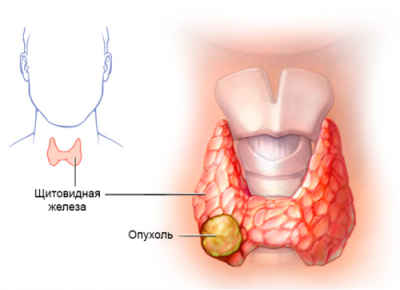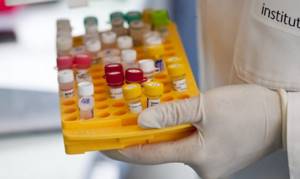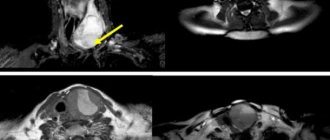Oncology
12/18/201701/24/2019 Chernenko A. L. 2987 Views oncology, thyroid gland
Today, thyroid cancer has every chance to occupy one of the leading positions in the list of common cancer diseases. Research methods such as palpation of the neck help to detect the presence of a tumor in 3-5% of patients, and ultrasound diagnoses 50% of tumors. Many diagnoses are benign, but 10-30% are malignant. Therefore, thyroid cancer is considered the most common pathology of the endocrine system.
Considering this trend, one of the leading goals of modern medicine is the development and implementation of innovative methods for non-invasive and cost-effective methods for the early diagnosis of thyroid cancer. Nowadays, tests for thyroid tumor markers are actively used, which can replace a large number of diagnostic procedures and detect the disease in the early stages.
- 1 Names of thyroid tumor markers
- 2 False results
- 3 Indications for tumor marker testing
- 4 Where can I check a tumor marker?
- 5 Preparing for a tumor marker test
- 6 General rules for taking the test
- 7 What is thyroid cancer
- 8 Conclusions
Names of thyroid tumor markers
To diagnose a patient with thyroid cancer, doctors use several types of tumor markers:
- Thyroglobulin – in people affected by thyroid cancer, the concentration of this substance increases sharply. Systematic checks can help in timely diagnosis of the disease both in the first stages of development and in more advanced stages of the disease with the onset of metastasis. If the test result does not exceed 10-11 ng/ml, we can talk about the full norm.
- Calcitonin is a tumor marker of the thyroid gland, used to detect the medullary type of tumor. Its level in blood tests varies depending on the size of the malignant neoplasm during its development. It is thanks to calcitonin that surgeons can identify the remains of altered cells or distant foci of metastasis after surgery. If the tumor is not completely removed, the analysis will be slightly overestimated, and if the tumor marker level increases over time, we can talk about a relapse.
In addition to the above tumor markers, there are also less popular tests for determining thyroid cancer. CEA and galactin-3 help detect malignant cells no worse than thyroglobulin. These proteins are the same and practically no different in patients suffering from thyroid cancer. The only difference is that when washed, they show a huge difference, so thyroglobulin is considered more informative.
| Normal indicators | Thyroglobulin | Calcitonin | REA |
| Women | 0-50 ng/ml | 3-5 ng/ml | 0-15 ng/ml |
| Men | 5.5-8 ng/ml | 5-50 ng/ml | 0-20 ng/ml |
Read further: CEA blood test - what it means, decoding and tumor marker norm
How much does the analysis cost?
The price of research in many cases is human life. Often these tests are indispensable, since other types of diagnostics are difficult. The cost of the analysis will be determined:
- Research methodology;
- Costs of reagents;
- Availability of modern equipment;
- Peculiarities of pricing of a particular establishment.
You can undergo diagnostics, take tests for tumor markers and get advice from a specialist in Moscow, at the RAS clinic. Appointments can be made on the website or by calling the numbers provided.
False results
The presence of a high concentration of tumor markers does not mean that a person has thyroid cancer. Quite often, additional protein synthesis is affected by certain changes in the human body. For this reason, the final diagnosis of oncology is always established after additional examination. A biopsy can determine the exact shape and stage of cancer.
Tumor markers can give a false result in the following cases:
- Inflammation of the liver.
- Hormonal imbalance.
- Tuberculosis.
- Bad habits.
- Ulcerative colitis.
- Cirrhosis of the liver.
- Pneumonia.
- Pregnancy.
- Aggravated hemorrhoids.
False results may be detected in the presence of benign tumors or cysts. These pathologies can be treated more sparingly and do not require urgent intervention.
What does a tumor marker show?
The results of the analysis will confirm the presence of a tumor process or refute this assumption along with other research methods, and will also make it possible to distinguish a cancerous tumor from a benign one.
Comparing the results before and after treatment will allow us to draw a conclusion about its effectiveness.
The obtained values make it possible to monitor the patient’s condition after treatment and identify relapse at an early stage.
Indications for tumor marker testing
Often, patients who visit a doctor and suspect they have a thyroid tumor want to undergo certain diagnostic tests, which cannot be called a reasonable action.
The specialist himself decides what and when he should examine and check. Such a decision largely depends on the clinical picture of the disease that is suspected in the first place.
Signs of thyroid cancer:
- Pain in the area where the thyroid gland is located (constant discomfort, feeling of a “lump in the throat”).
- Increase in the volume of lymph nodes in the neck (especially submandibular nodes).
- Hoarseness or loss of voice (aphonia).
- Detection of nodules, heterogeneous compactions in the thyroid cavity.
- Constantly bothersome cough for no apparent reason.
- Dyspnea.
- Dysfunction of the intestines and cardiovascular system.
- Central nervous system disorders (attacks of aggression, apathy, depression).
Donating blood to determine the level of tumor markers is carried out in one of the cases:
- To confirm or refute the diagnosis of thyroid cancer.
- A rapid increase in the volume of thyroid nodules, with a change in their consistency.
- Control after total resection of the thyroid gland.
- Evaluating the effectiveness and monitoring of ongoing anticancer therapy.
- Prediction of the clinical course of the pathology, the formation of a probable scenario of metastasis.
- A test to check for the onset of recurrence of thyroid cancer.
Causes and risk factors
Oncologists have not yet established what exactly causes endocrine organ cells to mutate into malignant ones, but the factors that contribute to this are well known.
- Radiation exposure, including during the treatment of other diseases in the head or neck area.
- Unfavorable heredity, the presence of similar pathologies in other relatives.
- Age. For men, the risk of developing a tumor increases by the age of 60; in women, this risk increases after 40 years.
- Iodine deficiency. Lack of iodine in tissues contributes to the appearance of follicular cancer.
- Stress. An unfavorable emotional background reduces the activity of the immune system.
- Hormonal imbalance. Malfunctions in the hormonal system can be caused by long-term disease of the reproductive organs, pregnancy or menopause in women.
Where can I check a tumor marker?
Tumor markers for the thyroid gland can be tested in a private laboratory or in public oncology centers. Often, people turn to independent laboratories for this service, which, for a fee, provide the final results in a short time. However, in order to get a transcript and consultation with an oncologist, it is better to contact a government agency.
The cost of the procedure varies from place to place. After passing the analysis and deciphering the doctor, additional examination may be required, consisting of ultrasound, MRI and other instrumental techniques, which are also available in private and public clinics.
Read further: List and rules for taking tests for thyroid hormones
How to feel about the results obtained?
These indicators are used to monitor the condition over time, so it is important to know their initial level. There are no universal tumor markers indicating a specific location, so they cannot be used as an independent diagnostic method.
Indicators may increase during pregnancy, acute and chronic diseases, so they cannot be interpreted unambiguously. Biochemical studies must be confirmed by clinical methods and consultation with specialists.
Preparing for a tumor marker test
Some time before the scheduled date of the test, you need to adhere to certain doctor’s recommendations in order to reduce the likelihood of errors and inaccuracies in the final result. Before taking a thyroid tumor marker test, you must:
- Blood is donated strictly on an empty stomach.
- The day before the test, you should avoid eating heavy foods and drinking any alcohol.
- The body must rest - the patient must limit physical activity for the whole day before the analysis.
- You cannot eat anything 8 hours before visiting the laboratory.
- If the patient is taking any medications, he must tell the doctor which ones and in what doses.
- A week before the test, you need to stop using iodine-containing and hormonal medications.
Submission rules
Before taking the tests, you should prepare. There is no big difference in preparation between types of tumor markers.
It is necessary to adhere to the general rules, and then the result will be as accurate as possible:
- If possible, it is recommended to donate blood in the morning, from 8 to 11 o’clock, but it is also allowed to wait 3-4 hours from the last meal of the day, on an empty stomach (at least 8 hours and no more than 14 hours of fasting, drinking water, in normal mode), avoid food overload the day before.
- Avoid drinking alcohol on the eve of the test.
- Do not smoke for at least 1 hour before the test.
- Avoid physical and emotional stress on the eve of the study.
- After arriving at the laboratory, rest for 10-20 minutes before taking blood samples.
- It is not advisable to donate blood for laboratory testing soon after physiotherapeutic procedures, instrumental examination and other medical interventions. After some medical procedures (such as a rectal examination or prostate biopsy before a PSA test), the laboratory test should be delayed for a few days.
- When monitoring laboratory parameters over time, it is recommended to conduct repeated tests under the same conditions: in the same laboratory (using the same method), donate blood at approximately the same time of day, etc.
It is imperative to inform the doctor about your recent (within a week) x-ray or other diagnostics, as well as about the medications you are taking.
When taking a PSA test, it is recommended to abstain from sexual intercourse for a week, and studies for tumor markers of the female reproductive system should be carried out not during menstruation.
Where and when should tumor markers be taken?
In order for the doctor to correctly interpret the test result (which can serve as an important diagnostic criterion for the disease), all recommendations for preparing for the study should be followed.
What is thyroid cancer
Thyroid cancer is an oncological disease that occurs with the formation of a malignant tumor in the thyroid gland, beginning its growth and development from the follicular, medullary or papillary cells of the organ.

Schematic illustration of what thyroid cancer looks like
Most of these formations belong to differentiated tumors - consisting of practically unchanged organ cells. Classification of thyroid oncology divides the disease into 4 types:
- Papillary carcinoma - this type accounts for about 80% of all cases of cancer of the thyroid gland. It grows slowly and affects only 1 lobe of the organ. Has the highest survival rates.
- Follicular carcinoma - 10% of all cases; it is especially often diagnosed in regions where iodine deficiency is observed. Does not affect the lymph nodes, but often affects the lungs and bones. The prognosis is not as favorable as in the case of papillary thyroid cancer, but with timely initiation of treatment, follicular carcinoma is completely curable.
- Medullary carcinoma - it is diagnosed in 6% of cases. It originates from glandular cells that synthesize the hormone calcitonin. Metastasizes to many organs, which often happens even before diagnosis. The prognosis is unfavorable.
- Anaplastic carcinoma is the rarest form of thyroid cancer, the incidence of which is only 2-4%. This is an undifferentiated type of tumor, the cells of which are not detected. Signs of anaplastic type thyroid cancer develop almost immediately; the tumor itself grows and metastasizes quickly, which prevents effective treatment.
Patient preparation rules
Standard conditions:
In the morning before 11-00, on an empty stomach, after 8-12 hours of fasting.
Possible:
during the working day of the ML “DILA” branches.
A break of at least 6 hours after eating (fatty foods should be excluded). Important:
talk to your doctor about taking calcium supplements.
You can add this study to your cart on this page
Markers of oncological pathology of various organs
Let us list specific markers for systems of the human body that are vulnerable to malignant neoplasms.
Gastrointestinal tract, pancreas and liver
If the patient’s relatives have had stomach cancer or the person himself suffers from problems with the digestive tract (ulcers, chronic gastritis, etc.), doctors prescribe a test for CA15-3 levels. This test is also needed for people over 50 years of age.
Doctors also use some tests to clarify the diagnosis. To do this, determine the content in the body:
- CA72-4 (considered a general analysis);
- CYFRA 21-1 Indicator of rectal problems. However, it is also a marker for lung cancer.
- LASA-P (general study);
- AFP (an indicator of pathology of the sigmoid and rectum, as well as the liver). Its concentration increases 3 months before the onset of the clinical picture.
- CA 125 (its amount increases with damage to the sigmoid colon).
- CA15-3 - increases in liver cancer;
- Ca19-9 and Ca 242 are indicators of an unfavorable state of the liver or pancreas.
- CA-50 is a specific marker for pancreatic cancer.
- NSE, or neuron-specific enolase: a marker for pancreatic cancer and other oncologies of the nervous and endocrine systems. It can also be used to detect retinoblastoma, a cancer of the retina.
However, these markers do not always accurately identify the affected area. To clarify the diagnosis, it is necessary to further examine the patient.
Thyroid
To monitor the status of this level, the level of thyroglobulin is checked. An increased amount of this substance is a sign of metastases or relapse. Normally, there is little of it - thyroglobulin is produced by the cells of the thyroid gland.
The medullary type of cancer is determined by the level of the hormone calcitonin. The larger the tumor and the more serious the stage of the disease, the higher its content in the body.
Lungs
To identify the disease, tests are done for Cyfra-21-1, as well as CEA/REA and NSE. The first study reveals degeneration of epithelial cells.
An increase in the amount of these substances requires additional research to diagnose non-small cell lung cancer.
Kidneys
The stage of tumor development is determined using the metabolic marker Tu M2-PK. The peculiarity of the pathological process in cells in this case is the absence of a cumulative effect. It turns out that in patients with kidney cancer, this substance quickly appears in the blood.
But this marker is also characteristic of the oncological process in the digestive tube of the mammary glands.
The patient is also prescribed a blood test to check for SCC. This glycoprotein is produced by flat epithelial cells, changing the structure of healthy cells and penetrating the cell membrane.
Bladder
Tumors in this organ are detected by the UBC tumor marker. This is a protein enzyme that enters the blood. An increase in its amount can be detected already at an early stage of the disease in 70% of patients. But the diagnosis should definitely be clarified through a blood test for NMP22.
This tumor marker is most often needed to monitor patients who are already being treated. With its help, doctors determine the effectiveness of therapy in order to make adjustments to the treatment regimen.
Another marker of bladder tumors is TPS, although it is also elevated in other cancers. A serious increase in its indicators indicates the occurrence of metastases.
Lymph nodes
In patients with lymph node cancer, the level of a protein antigen called β2-microglobulin increases. However, it is characteristic of neoplasms of various localizations. Its quantity allows us to determine the stage of the disease.
Brain
To verify the presence or absence of a brain tumor, you need to donate blood to determine To make a diagnosis, blood is taken to determine common tumor markers: PSA, AFP, CYFRA-21.1, Ca 15-3.
The latter marker is characteristic of breast cancer, but can also be a sign of metastases in the brain.
Neuroblastoma is characterized by increased NSE. However, sometimes it is a sign of leukemia or lung cancer.
Melanoma (skin cancer)
With this pathology, the amount of TA-90 and S-10 increases. A significant increase in their content is usually associated with metastases. Combining these studies with other tests is the key to informativeness and correct diagnosis of the disease.
However, this marker was discovered by scientists relatively recently - previously the disease was determined by other indicators, especially by the appearance of the sore spot.
Also important when examining a patient is the tumor marker s100 - this is a protein that signals skin cancer. However, sometimes its content increases with lupus erythematosus or other specific pathology.
Bones
TRAP 5b has become widespread in the diagnosis of bone cancer. This is an enzyme produced in osteoclasts. However, its content is different in the male and female body, so a professional oncologist must decipher the results.
Larynx
The key here is the common tumor marker CYFRA 21-1. This is a protein compound of epithelial tissue. The patient is also tested for SCC - an antigen of squamous cell cancer pathologies.
With a malignant tumor in the throat, its level exceeds the norm by 60 percent. However, an increase in this indicator is also possible in other diseases.
Adrenal glands
An accurate diagnosis is made after determining the amount of hormones in the urine and blood. The main study is on DEA-s.
The patient will also have to undergo tests for:
- CA 242;
- REA;
- CA 72-4;
- Tu M2-RK (unlike the others, this indicator is important for preventing relapses).
Male and female reproductive system
In women with ovarian cancer, an increase in hCG and CA-125 is found. In healthy people, the amount of the latter is minimal. Also, problems with the female reproductive glands indicate an increased amount of HE-4 in the patient, but this is also a marker of the oncological process in the endometrium. Benign changes in ovarian tissue are determined using the Roma index.
It is important to know that an increase in human chorionic gonadotropin is also characteristic of cancer of the male gonads (testicles). Also in this case, AFP increases.
If breast cancer is suspected, the doctor will refer the patient for a CA-15-3 test. This is a specific substance that signals the appearance of carcinoma in the mammary glands. In addition, the MSA antigen is examined for this purpose. This is a good way to monitor the condition of a patient already being treated.
Cervical cancer is determined by analysis of SCC, but oncology in the ENT organs and respiratory system is also detected.
Prostate-specific antigen levels increase in men with prostate cancer. The study of free prostate antigen allows you to determine the type of tumor (benign or malignant).
Use of tumor markers for prevention purposes
Particular attention should be paid to preventive measures for people at increased risk of developing a tumor:
- People who have previously had cancer and have recovered from it.
- For patients whose relatives died of cancer or had it but were cured: genetic predisposition to cancer is a scientifically proven fact.
- Persons living in conditions of high levels of radiation and working with radioactive substances. We are talking about employees of nuclear power plants, chemists and physicists, radiologists, etc.
- Men and women over 40 years of age. Males need a PSA test, as it signals the appearance of tumors in the prostate gland. Both sexes are recommended to have their CA-125 levels tested, as it is a marker for gonadal cancer.
In some cases, doctors recommend testing hCG (human chorionic gonadotropin) and alpha-fetoprotein. But other substances are not used for standard preventive screening.
Advantages of tumor markers over other diagnostic methods

This method cannot be used as the only one to make a final diagnosis. As a method of monitoring the regrowth of an excised tumor, this analysis is considered indispensable. It is also needed to monitor the effectiveness of therapy and the occurrence of relapses after tumor excision.
Using a tumor marker test in conjunction with other diagnostic methods increases the efficiency and accuracy of diagnosing thyroid cancer.
Normal tumor markers in women
Despite the high efficiency of diagnosing the amount of protein compounds in the blood and/or urine, as well as the risk of developing cancer in any person, the analysis is not prescribed to everyone, and it is not preventive for people who are not at risk and do not have any indications for this.
Checking the normal level of tumor markers for women is indicated in the following cases:
- There are cases of cancer in the family history.
- Benign neoplasms were previously diagnosed.
- Congenital pathologies.
- Received injuries, suffered serious illnesses in the pelvic organs and mammary glands.
- Control of metastases and treatment.
- Previously underwent oncology treatment (control of relapse and absence of metastases).
If after treatment the level of markers does not return to normal, it means that the selected program is ineffective.







